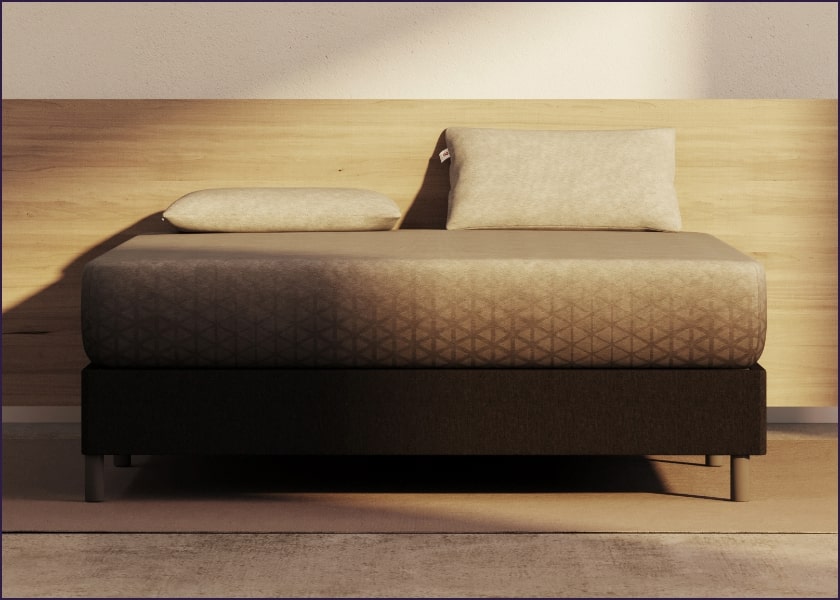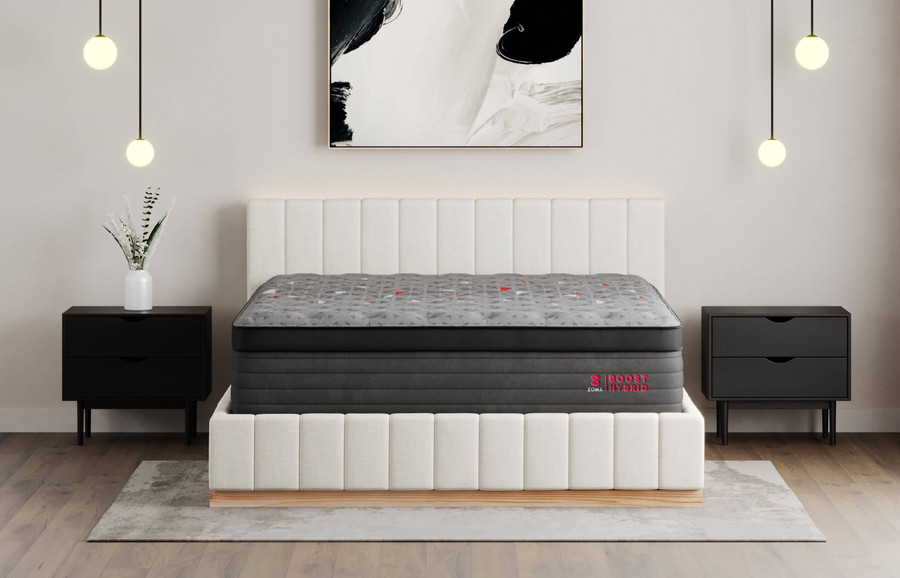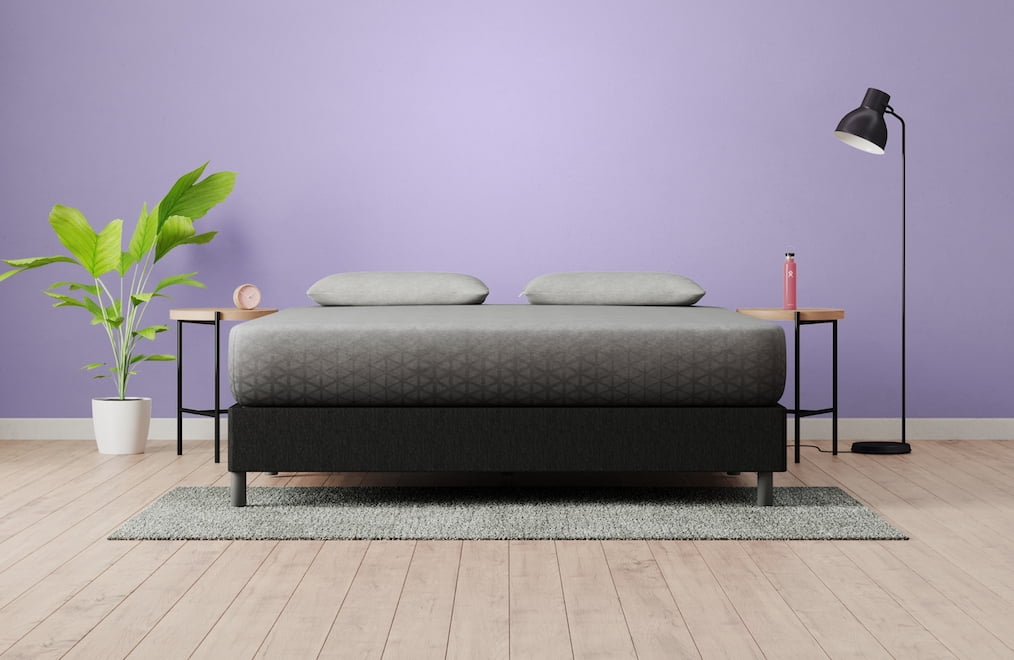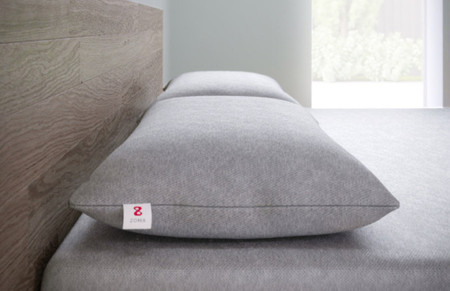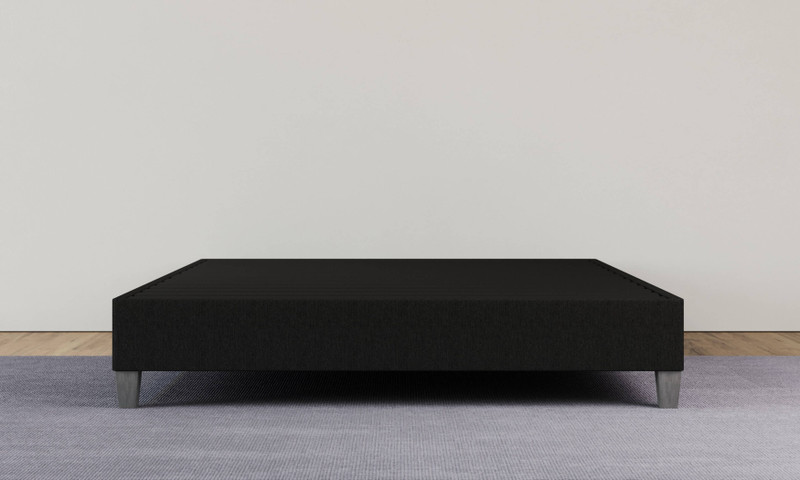
Shop Zoma Mattresses
Find the right fit for your sleep performance boost.
Why upgrade to Zoma?
IN THE NEWS
"The mattress athletes have always dreamed of"
Sleep on it.
Every Zoma bed comes with the same great benefits.
Need a reference?
We've got plenty.
Frequently asked questions.
How much should I spend on a mattress?
Mattresses can range pretty drastically in price because they all contain different materials and technologies. Typically, though, you can find a quality mattress between $500 and $2,000 (smaller-size mattresses costing less and larger beds costing more).
What happens if I buy a bed online and don’t like it?
When shopping online, check to see if the bed you’re considering comes with a sleep trial (99 percent of online mattresses do). If it does, you’ll have the option to return the mattress in that time frame. We suggest reading through the sleep trial information, too, to make sure there are no hidden return or restocking fees. Many will label their sleep trials as “risk-free,” meaning returns are free.
When is the best time to buy a mattress?
Mattress brands usually offer sales year-round, but it doesn’t have to be a big sale weekend to find discounts on beds. That said, major sale weekends are also a great time to shop for a new mattress.
We recommend shopping for a mattress around:
- President’s Day
- Memorial Day
- Fourth of July
- Labor Day
- Black Friday
- Cyber Monday
How long do mattresses last?
Different mattresses have different lifespans—memory foam mattresses usually last seven to ten years, latex mattresses can last up to fifteen years, hybrids start showing signs of wear after six or seven years, while innersprings typically break down after five.
What are Zoma’s sleep trial and return policies?
Every Zoma Mattress comes with a 100-night risk-free sleep trial starting the day it’s delivered. If you decide during the 100 nights that it isn’t the mattress of your dreams, you have the option to return it for a refund. To initiate a return, just give us a call. Please note: To ensure optimal adjustment, we ask customers to trial their mattress for at least 30 nights prior to initiating a return. This allows for a thorough experience to truly decide if the mattress is right for you.
Where is the Zoma Mattress made?
The Zoma Mattress is proudly made right here in the U.S. with CertiPUR-US® certified foams.
Will the Zoma have that “new mattress” smell?
All foam beds have the chance of off-gassing to some degree, it’s just part of the process (just like paint will have a certain smell after it’s applied and recently-purchased cars will have that “new car smell”). However, you can take comfort in knowing a faint off-gassing scent is totally harmless. If you’re sensitive to the odor, we suggest letting the bed air out for a few days before sleeping on it.
While harmless, we understand off-gassing isn’t necessarily pleasant to deal with, which is why we engineered our mattress to be low in VOCs. The Zoma Mattress is a lot less likely than other foam beds to off-gas and, if it does, the scent should fade away quickly.
Ready to Find Your Next Bed?
We hope our guide has answered all of your mattress-buying questions and made the process a bit easier. Just remember, reading mattress reviews is always helpful, never buy a bed without a warranty, and the “best mattress” is one that feels most comfortable for you!
Don’t be afraid to take advantage of sleep trials (you won’t know if a bed’s good for you until you try it) and check for sales before making a purchase (you can usually always save a couple of bucks, as mattress companies tend to have sales going on year-round).
If you have any questions, don’t hesitate to reach out and ask! At Zoma, we’re dedicated to helping sleepers of all needs and styles get the sleep they need to achieve peak performance in their daily lives.
So what are you waiting for? It’s time to find your new bed and get a good night’s sleep!
Complete your setup.
Designed to improve every aspect of your performance-enhancing sleep.
What Else Do I Need to
Know About Mattresses?
Mattress shopping isn’t the easiest of tasks, and we understand that. Attempting to choose the right bed when there are hundreds of mattresses to consider can quickly become overwhelming. Are foam or spring beds better? Do I need something super soft or extra firm? How can I find a comfortable bed at a reasonable price? Most of us aren’t super knowledgeable about mattress features, which can make searching for the right bed even more difficult. But don’t worry—we’re here to help.
With our years of experience in the mattress industry, we’ve put together this mattress buying guide to offer clarification and take you step-by-step through the decision-making process.
What is the Best Mattress?
This is a question many people have when starting their search for a new bed. Truth is—there is no one “best mattress” (even when brands claim they have the “best bed for all sleep styles”). To find the best mattress for YOU, it’s best to stop and consider what exactly you are looking for in a new mattress. Reflecting on your personal needs and sleeping habits can point you toward the most comfortable mattress rather quickly.
When taking the time to think about what you need from a bed, ask yourself these things:
- What type of mattress suits me best?
- What is my primary sleeping position? (Do you tend to sleep on your side, back, stomach, or do you toss and turn throughout the night?)
- Do I like a softer or firmer feel from a mattress?
- Do I wake up hot at night?
- Do I have any pre-existing aches and pains?
- Do I need something to alleviate sleep apnea or another sleep disorder?
- Am I sharing my mattress or do I need a bed just for myself?
And of course, you’ll want to set aside a budget before shopping, too. And believe us when we say, there’s no need to spend an arm and a leg on a new bed—you can find a high-quality, long-lasting mattress near the thousand-dollar mark. Typically, beds that cost thousands of dollars are made with pricey features that don’t actually help your sleep (like gold threading— who needs that?).
So without further ado, let’s find you the best mattress for your sleep needs.
Mattress Types
While there are hundreds (maybe thousands) of different mattresses to consider, there are only a few different types of mattresses. The most popular ones are memory foam, latex, hybrid, and innersprings. However, futon mattresses, airbeds, and water beds are also available.
In this guide, though, we’ll be sticking to discussing the most popular mattress types since they typically score higher in customer satisfaction than less common types, and they’re the most readily available.
Memory Foam Mattresses
Memory foam mattresses are some of the most popular beds today, largely due to the increase of online bed in a box brands. Online brands choose memory foam for their mattresses in a box because it’s the easiest mattress type to compress and roll up, and many sleepers find comfort on memory foam mattresses—they typically score highest in owner satisfaction ratings.
Many people love these beds for their ability to contour to your body and offer all-over comfort. They instantly alleviate pressure and offer a “cradling” feeling. While many describe memory foam as “cloud-like,” these beds are available in a variety of firmness options.
One drawback of memory foam is heat retention, which can be especially bothersome to naturally hot sleepers. Modern brands, such as ourselves, have found ways to combat this issue through the inclusion of cooling technologies. Cooling gels not only make the mattress cool-to-the-touch, but they also wick away body heat to prevent overheating. Apart from cooling gels, some brands use plant-based foams to better dissipate heat.
Latex Mattresses
Latex is another popular option due to its hypoallergenic nature. Plus, latex is just as easy to roll up and ship in a box as memory foam, making latex beds widely available.
There are two types of latex mattresses: synthetic latex beds and organic latex beds. While synthetic latex is a viable option for those with a latex allergy, we advise against buying one of these beds. Synthetic latex foam is manmade, chock-full of chemicals, and not very durable. These beds are rather affordable, but the savings usually aren’t worth it.
Organic latex mattresses, on the other hand, are long-lasting and chemical-free. These beds are contouring like memory foam but are bouncier, so instead of “cradling” you like memory foam, latex keeps you lifted—for this reason, many feel latex beds are firmer than memory foam. But again, you can find latex beds in a number of firmness options.
Latex beds are typically more expensive than memory foam, but since they offer many of the same benefits as memory foam, many people opt for memory foam to save some money.
Hybrid Mattresses
Hybrid mattresses combine all-foam and innerspring mattresses to offer sleepers the benefits of both. True hybrid mattresses contain at least two inches of foam in the comfort layer—enough to offer adequate cushioning comfort and pressure relief. Below the foam layer(s), these beds have a pocketed coil system to give the bed added bounce.
Hybrid mattresses are loved by many because they offer the traditional bounciness that we’re used to from innerspring mattresses while also providing much-needed pressure relief to prevent pain. Typically, we recommend these beds for somebody who doesn’t want an all-foam bed but still needs the pain relief provided by foam layers.
Hybrids are also a great option for hot sleepers because their inner coil systems allow for better airflow, preventing heat retention.
Hybrid mattresses are typically more expensive than all-foam beds because they contain both foams and coils. However, hybrids aren’t as long-lasting as memory foam or latex mattresses, as their coil systems wear down and cause sagging after only six or seven years. That said, you can still get a decade worth of use (or more in some instances) out of a high-quality hybrid.
Innerspring Mattresses
Innerspring mattresses are last on our list because, despite their popularity for many years, these beds rank the lowest in customer satisfaction. While they’re bouncy and affordable, they’re not contouring or pressure-relieving, so they’re a bad option for people with any aches or pains.
Many innerspring beds have cushioning materials sewn into their covers or added via pillow and Euro tops, but even those additions can’t provide adequate pressure relief for long. Typically, pillow tops and Euro tops break down quickly since they’re so thin.
Innerspring mattresses are pretty breathable since they are made with open coil systems, but with that, it’s easy for dust mites, dead skin cells, and other allergens to settle in your mattress and cause irritations.
These beds also have the shortest expected lifespan, typically needing to be replaced after five or so years.
Considering all of that, we don’t really recommend innerspring mattresses. However, an innerspring can work if you need the bare minimum from a bed and don’t necessarily need a mattress to last a long time (for example: you’re temporarily relocating).
Once you choose the mattress type that fits you best, then you can determine the ideal firmness for your new bed.
Sleeping Positions
We all tend to have a favorite sleeping position; even combination sleepers will spend more time in one position over others. Each sleeping position requires a different kind of support, so mattresses for side sleepers will feel different than beds recommended for stomach sleepers.
Determining your preferred sleep style will point you toward the appropriate firmness option for your needs. However, don’t forget to think about your body type, too. Sleepers over 230 pounds will need to choose something firmer than what’s recommended to prevent excessive sinkage. Petite sleepers, on the other hand, will want something a tad softer than what’s recommended below, as they need more comfort to properly alleviate pressure.
Side Sleepers
Side sleeping is the most common position, with 70 percent of us choosing to snooze on our sides. With that, many brands tailor their mattresses to be comfortable for side sleeping—side sleepers will never feel short on options!
Side sleepers need a mattress soft enough to cushion the shoulders and hips to prevent pressure points and pain. Typically, side sleepers go for medium to soft mattresses. Mattresses with a comfort layer of memory foam or latex are best, and check the thickness of the comfort layer, too. Comfort layers at least 3 inches thick offer just enough cushion to allow for deeper compression of those joints.
We should note, innerspring mattresses are not recommended for side sleepers as they lack a true comfort layer.
Back Sleepers
Back sleepers need a bed to maintain neutral spinal alignment while laying flat on your back. The key here is to find a bed firm enough to prevent the hips from dipping too far, throwing your spine out of alignment. Depending on body weight, back sleepers can find medium-soft, medium, or medium-firm mattresses comfortable.
We advise against ultra-soft beds for back sleepers because they aren’t supportive enough, and ultra-firm beds because they’re not pressure-relieving enough and can cause pain in the shoulder blades.
Stomach Sleepers
We do not recommend stomach sleeping. It’s actually the unhealthiest way to sleep. When you sleep belly down, your midsection sinks into the mattress and causes your spine to arch unnaturally. Plus, many stomach sleepers rest with their neck turned to the side to breathe. Sleeping with an arched back and a twisted neck is very hard on the spine. In addition to brief discomfort upon waking, stomach sleeping often leads to long-term pain.
If you’re a stomach sleeper, we recommend switching to side sleeping and using a body pillow in front of you to prevent rolling onto your belly. Transitioning to side sleeping is usually easier than training yourself to sleep on your back.
If you find it too difficult to switch sleeping habits, or you’re a dedicated stomach sleeper, then we suggest a very firm mattress to keep your stomach lifted and your spine aligned.
Combination Sleepers
Combination sleepers switch from back to side to stomach sleeping throughout the night, making it a little trickier to find the perfect mattress. If you tend to toss and turn, the safest bet is to go with a medium mattress. Medium beds blend comfort and support evenly to accommodate a wider variety of sleep styles and body types (this is also why many people choose medium mattresses for guest rooms).
Mattress Firmness Scale
When browsing beds, you’ll notice most brands rate the feel of their beds on a “Firmness Scale,” with 1 being the softest and 10 being the firmest (some brands set up the scale oppositely, with 1 being firm and 10 being plush).
Using what you know about your sleep style and these firmness scales, you can typically gauge whether or not a bed will feel comfortable for you without ever trying it. This is especially helpful if you’re buying online, and can save you the time you would have spent trying out beds in brick and mortar stores.
Plus, knowing the firmness you want from your mattress can significantly narrow down your options.
Other Considerations
Apart from mattress type, sleep style, and body type, you’ll also have to consider whether or not you want cooling or pain-relieving features in a new bed. More importantly, you’ll also have to determine the right mattress size.
Mattresses for Hot Sleepers
If you tend to wake up with night sweats or you’re just uncomfortably warm, you’ll want to find a mattress designed for breathability.
Memory foam beds typically have cooling gels or are made from plant-based oils to promote airflow, while hybrid mattresses contain pocketed coils to prevent heat build-up. Latex beds are naturally cooling, so they’re loved by many hot sleepers.
You’ll also want to pay attention to the materials in your mattress cover. Breathable fabrics such as cotton and wool allow for better airflow than synthetic blends. Some brands even infuse cooling technologies into their covers, too.
Mattresses for Aches and Pains
If you live with aches and pains, whether it’s from a recent surgery or a long-term painful condition, you’ll want to find a mattress built with zoned technologies. All mattresses offer some level of support, but zoned technologies take that one step further, specifically facilitating healthy spinal alignment.
Zoned technologies, oftentimes called surface modification technologies, offer dynamic full-body support. They’re designed to feel firmer under your torso to keep your midsection lifted and softer under your shoulder blades and hips to prevent pain. These technologies can improve comfort for those of all sleep styles, but they’re especially useful for side sleepers. The best mattresses for back pain almost always contain zoned technologies.
Mattresses for Couples
If you don’t have to share your mattress, motion transfer and mattress size aren’t as big of an issue—you can choose whatever mattress size you like as long as it fits within your bedroom, and you won’t have to worry about a partner waking you.
However, for couples, choosing a mattress for two people requires a little more thought. First, you want a mattress that isolates motion, that way you won’t be disturbed by your partner’s movements.
If you share the bed with somebody on a different schedule than you, a mattress that isolates motion can prevent them from waking you when they go to bed or get up in the morning. Motion isolation is also nice for those who share the bed with a restless sleeper, as it keeps their tossing and turning from impeding your sleep quality.
Next, determine the best mattress size for you, your partner, and your bedroom. Queens, kings, and California kings are the most popular among couples. Queens are better for those with smaller bedrooms while kings and Cal kings fit nicely in spacious master bedrooms.
Mattress Sizes
While we just covered mattress sizes for couples, we’d be remiss to not mention other available options. Smaller mattress sizes are great for children, growing teens, and single adults. They’re also a go-to option for people living in smaller apartments or dorms since they’re space-saving.
Below, we list the standard mattress sizes and their dimensions so you can determine what works best for you.
- Crib: 27.25 inches by 51 inches
- Small Single: 30 inches by 75 inches
- Twin: 38 inches by 74 inches
- Twin XL: 38 inches by 80 inches
- Full: 54 inches by 75 inches
- Full XL: 54 inches by 80 inches
- Queen: 60 inches by 80 inches
- King: 76 inches by 80 inches
- California king: 72 inches by 84 inches
When deciding between standard and XL variations, consider legroom. For example, twins are best for children while twin XLs are better for teenagers and adults.
If you’re having trouble deciding between a king or a California king, ask yourself, “Do I care more about wiggle room or legroom?” California kings are four inches narrower than kings, but they’re four inches longer, so they’re recommended for taller people. Unless you’re over 6 feet tall, you’ll likely find a standard king perfectly comfortable.
Best Places to Shop
Congrats! Now, you should have a pretty good idea of what you need from a mattress—that wasn’t so hard, right? Knowing what you need from a mattress, you can now begin the search for a new bed. But you may be wondering, should you shop in-store or online?
For years, going out and testing a bunch of mattresses was the only way to shop for a new bed, and many felt buying a mattress sight unseen is just crazy. However, there are benefits to both—shopping online comes with lengthy sleep trials while shopping in-store usually means same-day delivery. Determining where to start ultimately comes down to personal preference.
We should mention, though, that shopping online typically comes with greater savings than going in person. Brick and mortar mattress stores typically have to hike up the prices of their products to cover overhead costs. Alternatively, online brands sell direct-to-consumer and can offer better deals. Plus, almost any bed you buy online will come with free shipping, whereas you typically have to pay delivery fees to brick and mortar stores or deal with the hassle of transporting the bed home yourself.
If you’re shopping on a tighter budget, we suggest starting online. If you have money to spend, you can find a good mattress online or in-store.
Regardless of how you buy, it’s a good idea to choose a mattress with a trial period or return policy. Even if you have the chance to test the bed before you buy it, a 15-minute in-store test run isn’t enough to determine if a mattress is really the right fit. Return policies give you about 30 days to test a mattress out and return if you’re dissatisfied, while sleep trials usually give you a couple of months to test a bed and decide if it’s right for you.
Amazon is also a great place to find budget-friendly beds, and many online mattress brands also have Amazon storefronts. For Prime Members, this means fast and free shipping, too. Just be cautious on Amazon, as there are plenty of unauthorized, third-party sellers on there offering brand name products at crazy low prices. Always check to see who you’re buying from, and if the deal seems too good to be true, it probably is.
Choosing the Right Foundation
Once you’ve found the right bed, you’ll need to pair it with a sturdy foundation to keep it in good shape. Many mattress warranties will require a specific type of foundation to meet guidelines (and if you ever file a warranty claim, they’ll likely ask you to send pictures of the mattress’s foundation, too).
To determine what your bed needs, read through the warranty agreement. For the most part, though, guidelines are pretty basic across the board.
Innerspring mattresses can be kept on box springs, but they’re the only kind of mattress compatible with box springs these days. However, if you have a box spring at home that you wish to keep using, you can add a bunkie board or piece of moisture-resistant plywood to the top of it to makeshift a more solid mattress foundation.
Memory foam, latex, and hybrid mattresses should all be kept on a solid or slatted mattress foundation. With that, they can also work on platform beds and adjustable bed frames, too. When buying slatted foundations, make sure the slats are no more than 3 inches apart for memory foam beds and 2 inches apart for latex mattresses (latex is a bit heavier than memory foam and needs extra support).
If you’ve bought a slatted foundation with slats that are too far apart, we suggest filling the gaps with additional slats or throwing a bunkie board on top. Slatted foundations are better for hot sleepers since they help hot air flow out of the bottom of the bed.
Many mattress brands will sell foundations designed to pair with their beds. In addition to our mattress, we also sell the Zoma Foundation with a perfectly-placed slat pack and an Adjustable Bed with a solid base, so you can get everything you need for your new bed all in one place.
Finding the Best Mattress Accessories
Of course, you’ll need bed sheets, a mattress protector, and a duvet or comforter, too.
When choosing bed sheets, comforters, and duvets, consider the time of year and whether or not you’re a hot sleeper. If you’re prone to night sweats, you’ll want to choose lightweight, breathable fabrics like cotton or Tencel®. If you are looking for cozy comfort, you may prefer flannel sheets. Going with cotton sheets is the safest bet, as they’re versatile enough to keep you cool in the summer and warm in the colder seasons.
When deciding between duvets or comforters, think about maintenance and appearance. Comforters can’t be washed as easily as duvets, and they also come as one piece, so you can’t switch out covers if you want your comforter to have a different look. However, comforters are usually not as expensive as duvets since you don’t have to buy compatible covers to go with them. Though they’re not as easy to wash as duvets, many of them can be cleaned at a laundromat or dry cleaner.
Lastly, and we cannot stress this enough, make sure to cover your mattress with a protector. Choose one that’s waterproof, and ideally, resistant to bed bugs, too. Mattress protectors shield your mattress from spills and prevent sweat and body oils from seeping through sheets and staining your mattress’s cover (if you stain your mattress, it’ll void your warranty!). These mattress accessories also prevent accidents from ruining your bed, and since mattresses are rather costly, you want to do everything you can to protect your investment.
Disposing of Your Old Mattress
The last step when replacing your mattress is disposing of your old bed. You can’t just toss your old bed out in the trash—not only is that bad for our planet, but many waste management companies won’t bother to pick it up. Instead, we suggest having it responsibly recycled.
Many junk removal services will take mattresses and have them recycled or repurposed. Just give them a call, arrange a pick-up time, and leave the mattress at your front door or curb, and they’ll swing by and grab it. Junk removal services do come with a fee, though.
Another option is to find a mattress recycling center near your home and take your old mattress there yourself. If the bed is small, it can possibly fit in the back of your vehicle. Larger mattresses will have to be securely strapped to the top of your car. Strapping a mattress to the roof of your vehicle isn’t illegal or dangerous as long as it’s securely tied down. We also suggest avoiding busy streets or highways when you have a mattress on your roof. If you can, take back roads to your destination.
If your old mattress is still in good shape (say it just wasn’t right for you and you are looking for a replacement) and can be donated, that’s also an option. Just please avoid trying to donate over-used or stained beds. Before donating the bed, give it a good look over—if you wouldn’t sleep on it, you shouldn’t expect others to, either.
Our Zoma Mattress
Now that we’ve covered everything you need to know about finding a new bed and getting rid of your old one, let’s talk about whether or not our Zoma can work for you.
We designed our Zoma Mattress after years of research—we wanted to offer a truly unique sleeping experience, and not flood the mattress-sphere with just another bed in a box. Several designs and prototypes later, the Zoma was finally the sleep-promoting product we sought out to make.
Our Zoma Mattress has a 3-layer construction, stands 11 inches tall, and is medium in firmness. We recommend this mattress for side, back, and combination sleepers. Stomach sleepers, on the other hand, need firmer support than what our Zoma provides to maintain healthy alignment.
What makes our mattress different from other online mattresses is its technologies.
We originally designed this bed for athletes and those with active lifestyles to boost recovery and ease soreness (whether you’re a runner or you work a physically-demanding job). And while yes, our mattress can improve the sleep of active, busy people, it can upgrade anybody’s quality of rest with its pressure-relieving memory foam and zoned support technology, Triangulex™.
The comfort layer of our Zoma is contouring, adaptable memory foam, so it molds to your body for immediate comfort and pain relief. We also infuse cooling gels in this layer to wick away heat and prevent hot nights.
In the comfort layer, we include Triangulex™ technology for superior spinal support. Triangulex™ contains hundreds of triangle-shaped cutouts to offer more support under your torso and better pressure relief under the shoulders and hips. Its design perfectly promotes healthy sleeping positions.
Our bed also contains a responsive transition layer to prevent uncomfortable sinkage and a sturdy core to resist wear and tear (even for those over 230 pounds). And we back every mattress with a 10-year warranty, too.
We strive to offer our beds at an affordable price, and we cut costs with eco-friendly shipping and selling online-only. You can score a queen size Zoma Mattress for only $750.
Every Zoma Mattress comes with a 100-night sleep trial so you can test it out at home and decide if it meets your sleep needs. If it does, excellent! If not, that’s okay, too—just give us a call after 30 nights and we’ll initiate a refund, no questions asked.




